Plants
Best Conditions for Ginger Root Growth Explained
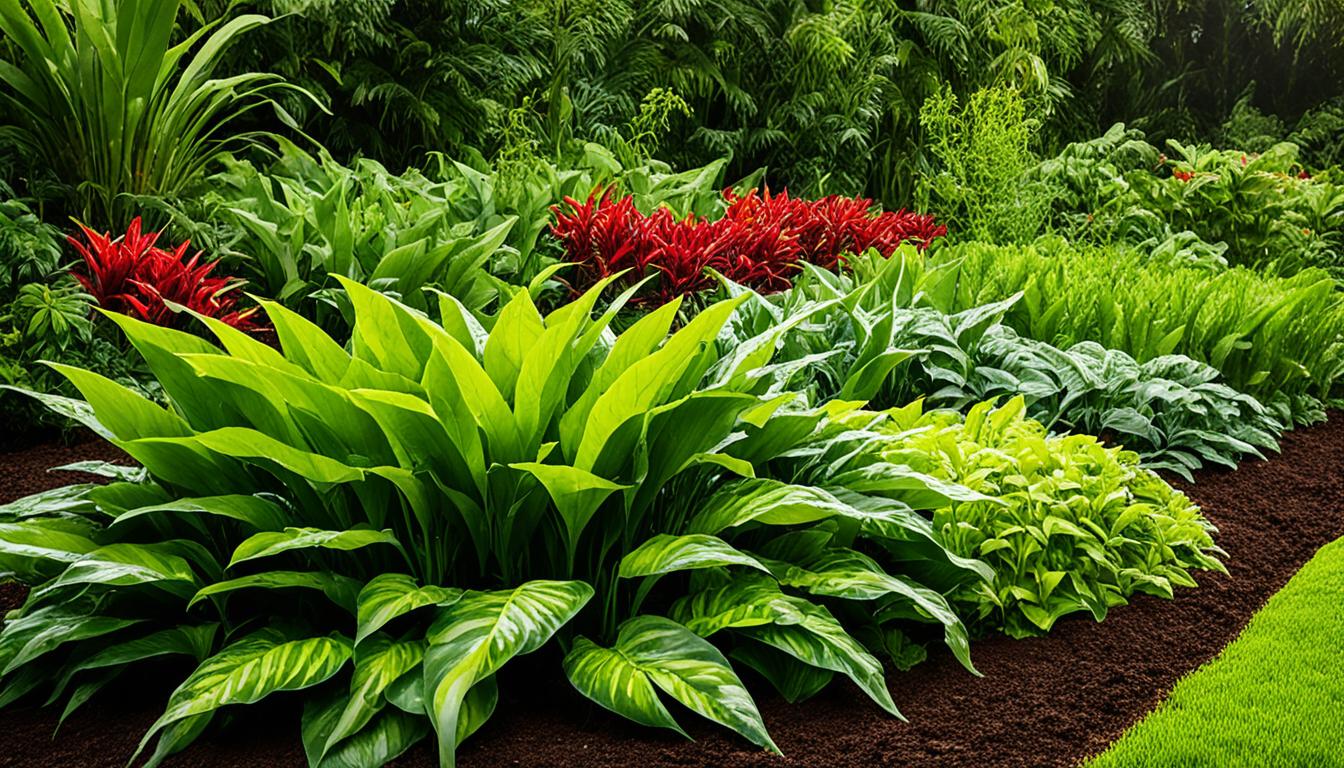
Ginger, known for its unique flavor and medicinal properties, is a versatile root used in everything from cooking to herbal remedies. But did you know that the success of ginger cultivation depends heavily on the conditions in which it is grown? Creating the best conditions for ginger root growth is essential to yield a bountiful harvest and vibrant plants.
From temperature to soil quality and moisture levels, each aspect plays a crucial role in ginger’s growth and well-being. By understanding the optimal conditions, gardeners and enthusiasts can replicate ginger’s tropical habitat and cultivate healthy plants with exceptional flavor and aroma.
In this article, we will explore the optimal conditions necessary for ginger root growth, offering insights and techniques to help you grow ginger successfully. Whether you’re an experienced gardener or a beginner with a green thumb, this guide will provide valuable knowledge to enhance your ginger cultivation.
Key Takeaways:
- Ginger root growth requires specific conditions to thrive.
- Temperature, soil quality, moisture, and shade are essential factors.
- Best practices include using organic matter, maintaining proper drainage, and providing dappled shade.
- Ginger can be grown in containers, hoop houses, or greenhouses.
- Pre-sprouting ginger indoors can maximize the growing season.
Optimal Soil Conditions for Ginger Root Growth
Ginger plants require optimal soil conditions to thrive and produce healthy root growth. By providing the right environment, gardeners can ensure that their ginger plants receive the necessary nutrients and support for robust growth. Here are some essential factors to consider when creating optimal soil conditions for ginger root growth:
- Rich in Organic Matter: Ginger prefers soil that is rich in organic matter, which provides essential nutrients and promotes healthy root development. Adding lots of compost to the ground or using a peat and wood bark-based soilless medium mixed with sand in containers can help create a fertile growing medium.
- Organic Fertilizers and Worm Castings: Supplementing the soil with organic fertilizers and worm castings can further enhance the nutrient content, ensuring that ginger plants have access to the necessary elements for their growth. These natural amendments provide a slow-release source of nutrients, promoting long-term plant health.
- Good Drainage: It is crucial to ensure good drainage in the soil to prevent waterlogging, as standing water can negatively affect ginger growth. To improve drainage, incorporating coarse sand or perlite into the soil can help create a well-draining environment for the roots.
- pH Levels: Maintaining the right pH levels is essential for optimal ginger growth. Ginger plants prefer slightly acidic soil, with pH levels between 5.5 and 6.5. Testing the soil’s pH and making appropriate adjustments using organic soil amendments or sulfur can help create the ideal conditions for ginger plants.
By creating soil conditions that are rich in organic matter, well-draining, and with the right pH levels, gardeners can provide the optimal environment for ginger root growth. The next section will explore the ideal temperature range for ginger plants and the impact it has on their growth and development.
Soil Conditions for Ginger Root Growth
| Soil Condition | Description |
|---|---|
| Rich in organic matter | Ginger prefers soil that is rich in organic matter, such as compost or a peat and wood bark-based soilless medium mixed with sand. |
| Organic fertilizers and worm castings | Adding organic fertilizers and worm castings can provide essential nutrients for ginger plants. |
| Good drainage | Ensuring good drainage in the soil is crucial to prevent waterlogging, which can negatively affect ginger growth. |
| pH levels between 5.5 and 6.5 | Maintaining slightly acidic soil with pH levels between 5.5 and 6.5 is ideal for ginger plants. |
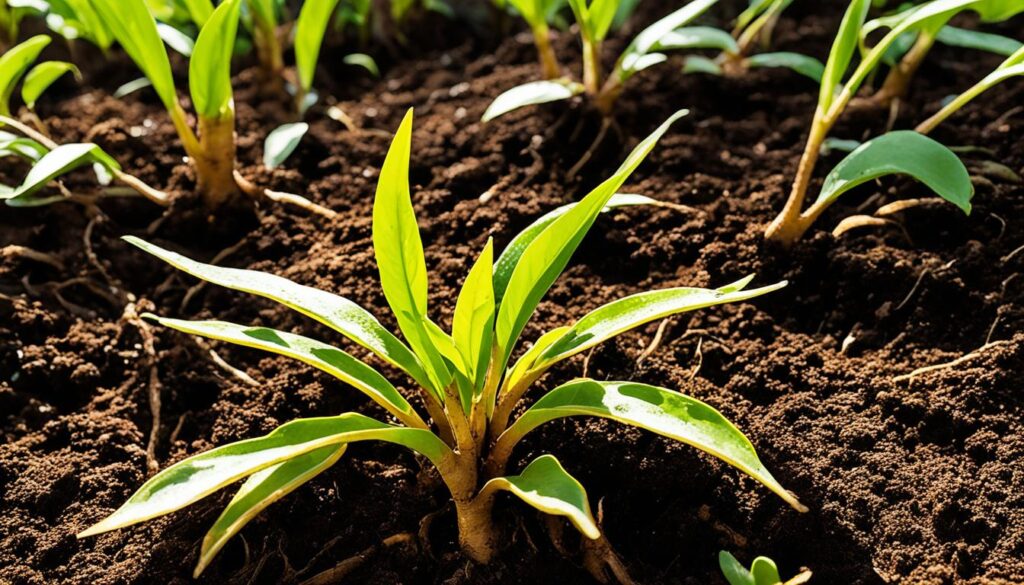
Ideal Temperature Range for Ginger Root Growth
Ginger is a tropical plant that thrives in warm temperatures, making the ideal temperature range a crucial factor for its successful growth. The ideal temperature range for ginger root growth is 70° to 90°F (21° to 32°C). This range provides the optimal conditions for ginger plants to thrive and produce healthy rhizomes.
When growing ginger, it is important to consider the nighttime temperatures as well. It is recommended to plant ginger when nighttime temperatures are consistently above 55°F (13°C). Cooler temperatures can slow down the growth of ginger plants or even cause damage to them, hindering their development.
In regions with colder climates, it may be challenging to maintain these ideal temperatures for ginger growth. However, there are ways to overcome this obstacle and still grow ginger successfully. Growing ginger indoors in a controlled environment, such as a greenhouse or conservatory, can provide the necessary warmth for ginger plants to thrive.
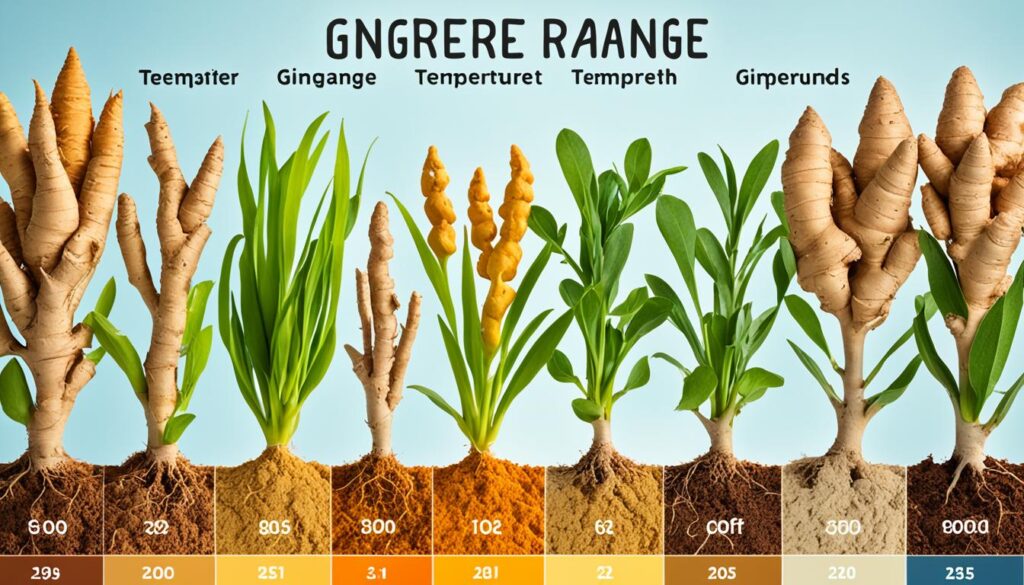
Importance of Moisture for Ginger Root Growth
Ginger is a moisture-loving plant that requires consistent watering to thrive and produce healthy and flavorful roots. Proper moisture management is essential for ginger root growth.
The soil should be kept evenly moist, providing enough water to meet the plant’s needs without overwatering or allowing the soil to dry out completely. Overwatering can lead to waterlogged conditions, which can suffocate the roots and promote the development of root rot. Conversely, letting the soil dry out completely can cause stress to the plant and hinder its growth.
Watering frequency may vary depending on factors such as the climate, humidity levels, and container size. In general, it is advisable to water ginger plants whenever the top inch of soil feels slightly dry. This allows for proper hydration without risking waterlogging.
Proper irrigation techniques and good drainage are crucial for maintaining the ideal moisture levels for ginger root growth. In containers, ensure that there are drainage holes to prevent water from pooling at the bottom. For in-ground planting, selecting a well-draining soil or amending the soil with organic matter can improve moisture balance.
Expert Tip:
When watering ginger plants, it’s important to give them a deep soak, allowing the water to penetrate the root zone. However, avoid overhead watering as it can lead to the development of fungal diseases. Instead, direct the water towards the base of the plant or use a drip irrigation system to ensure precise watering.
By maintaining the right moisture levels through proper watering techniques and good drainage, gardeners can provide the optimal conditions for ginger root growth, ensuring healthy plants and a bountiful harvest.
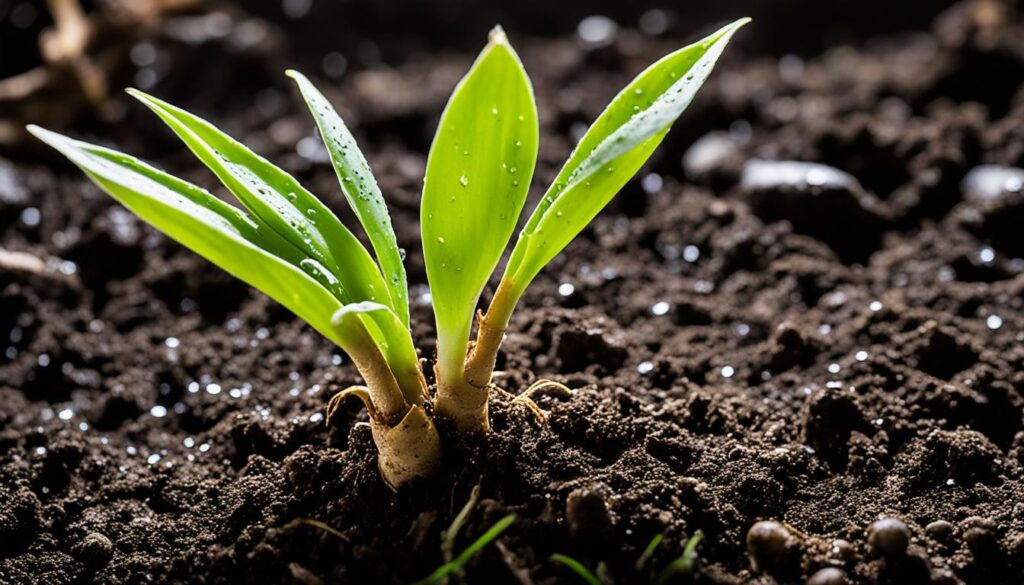
Moisture Guidelines for Ginger Root Growth
| Moisture Level | Signs | Recommended Action |
|---|---|---|
| Soggy or Waterlogged | Wilting, yellowing leaves; foul odor; root rot | Improve drainage by adding organic matter; reduce watering frequency |
| Too Dry | Wilting, dry soil; slow growth | Increase watering frequency; mulch around plants to retain moisture |
| Evenly Moist | Healthy foliage; steady growth | Continue regular watering; monitor moisture levels |
Benefits of Dappled Shade for Ginger Root Growth
Ginger plants thrive in dappled shade, which provides them with a balanced environment for optimal growth. The benefits of dappled shade include protection from direct sunlight, prevention of soil overheating and excessive drying, and maintenance of suitable moisture levels.
Planting ginger under the shelter of taller crops or using shade cloth can create the perfect conditions for ginger root growth. The dappled shade allows the plants to receive filtered sunlight, which is essential for photosynthesis while reducing the risk of sunburn or heat stress.
“Dappled shade is like a natural sunscreen for ginger plants, shielding them from the harsh rays of the sun and maintaining a cool, comfortable environment.”
By providing dappled shade, you can create an ideal microclimate for ginger root growth. The shade helps regulate soil temperatures, preventing it from becoming too hot and drying out too quickly. This is particularly important for ginger, as it prefers consistently moist soil.
Moreover, dappled shade helps to reduce water evaporation, allowing the roots to stay moist for longer periods. This helps the ginger plants establish a strong root system and absorb essential nutrients from the soil, promoting healthy growth and development.
When setting up dappled shade for your ginger plants, it is important to strike a balance. While providing shade, ensure that there is still enough light penetration for proper photosynthesis. Ginger plants need adequate sunlight to produce energy for growth, but too much direct sunlight can be detrimental.
Consider planting ginger in an area where it receives morning sun and partial afternoon shade. This allows the plants to benefit from the warmth and light of the morning sun while being shielded from the intense heat of the afternoon sun.
To summarize, dappled shade provides numerous benefits for ginger root growth, including protection from direct sunlight, prevention of soil overheating and excessive drying, and maintenance of suitable moisture levels. By implementing dappled shade techniques, you can create an ideal environment for ginger plants to thrive and produce a bountiful harvest.
Pros and Cons of Dappled Shade for Ginger Root Growth
| Benefits of Dappled Shade | Considerations for Dappled Shade |
|---|---|
| Protection from direct sunlight | Ensure there is still enough light for photosynthesis |
| Prevents soil overheating | Find a balance between shade and sunlight |
| Reduces soil drying out | Choose an area with morning sun and partial afternoon shade |
| Maintains suitable moisture levels |

Recommended Planting Techniques for Ginger Root Growth
When it comes to cultivating ginger, selecting the right planting technique is crucial for successful root growth. Whether using whole rhizomes or cut pieces, understanding the proper methods will optimize your ginger harvest. Here are some recommended planting techniques:
1. Using Whole Rhizomes
Planting ginger with whole rhizomes is a straightforward technique that yields excellent results. Look for healthy, plump rhizomes with well-developed buds or eyes. These larger rhizomes tend to grow quicker and produce more robust plants.
To plant whole rhizomes:
- Prepare the soil by loosening it with a garden fork or tiller.
- Dig a trench that is about 6 to 8 inches deep.
- Place the rhizomes in the trench with the eyes facing upwards.
- Cover the rhizomes with soil, ensuring they are well-buried but not too deep.
- Water gently to settle the soil.
2. Using Cut Rhizome Pieces
If you have limited planting material or want to maximize your ginger yield, using cut rhizome pieces is a viable option. When cutting the rhizomes, ensure each piece has at least one bud or eye.
To plant cut rhizome pieces:
- Prepare the soil or select a suitable container with good drainage.
- Fill the container with a well-draining potting mix or amend the soil with organic matter.
- Place the cut rhizome pieces in the soil or container, burying them about 1 to 2 inches deep.
- Water thoroughly to encourage root establishment.
Note: Make sure there is adequate room for the rhizomes to grow when planting in containers. This will prevent overcrowding and promote healthier plant development.
3. Pre-sprouting Indoors
For gardeners who wish to extend the growing season or gain a head start on ginger production, pre-sprouting indoors is an effective technique. This method involves placing the rhizomes in a tray with moist compost or paper towel to encourage early sprouting.
To pre-sprout ginger indoors:
- Select healthy rhizomes with visible eyes.
- Fill a tray with moist compost or lay paper towels on a flat surface.
- Place the rhizomes on the compost or paper towels, positioning them with the eyes facing upwards.
- Maintain the moisture level by misting regularly.
- Keep the tray or paper towels in a warm location with indirect sunlight.
- Once sprouts have developed, carefully transplant them into individual containers or directly into the ground.
Pre-sprouting allows for an earlier harvest and ensures that the ginger plants have a strong start before being exposed to outdoor conditions.
Remember, ginger responds well to a warm and humid environment, so providing the optimal conditions during the planting process will contribute to its overall growth and development.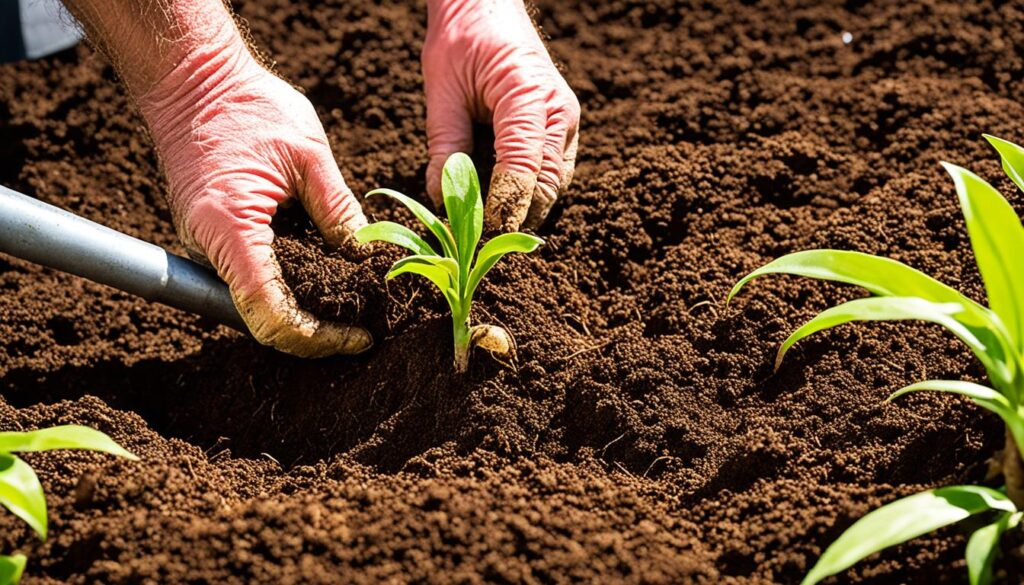
| Planting Technique | Advantages | Disadvantages |
|---|---|---|
| Using Whole Rhizomes | – Quicker growth – Larger harvests |
– Requires more planting material – Limited control over spacing |
| Using Cut Rhizome Pieces | – Maximizes planting material – Allows for precise spacing |
– Slower initial growth – Smaller rhizome yields |
| Pre-sprouting Indoors | – Provides an early start – Enhances germination rates |
– Requires additional indoor space – Requires regular misting |
Care Tips for Ginger Root Growth
Proper care is crucial for the successful growth of ginger roots. By providing the right conditions, you can ensure healthy plants and a bountiful harvest. Here are some essential care tips for ginger root growth:
1. Warmth: Ginger plants thrive in warm environments, so it’s important to provide them with a suitable temperature. During the summer, whether you are growing ginger outdoors or indoors, it’s beneficial to place the plants in a warm and humid area.
2. Humidity: Humidity is another important factor for ginger root growth. If you are growing ginger indoors, placing the plant near a bright windowsill can help simulate the ideal conditions. Additionally, occasional misting with water can create a humid environment that mimics the plant’s natural habitat.
3. Moisture: Adequate moisture levels are essential for ginger plants. It’s important to water the plants regularly, ensuring that the soil is evenly moist. However, be cautious not to overwater, as excessive moisture can lead to root rot. To promote proper drainage, use pots with drainage holes and allow the soil to dry out slightly between waterings.
4. Mulching: Applying a layer of mulch around ginger plants can serve multiple benefits. Mulching helps to conserve moisture in the soil, reducing the frequency of watering required. Additionally, it helps to suppress weed growth, keeping the area around the ginger plants clean and tidy.
Ginger plants require a combination of warmth, humidity, moisture, and proper drainage to thrive. By following these care tips, you can create optimal conditions for ginger root growth and enjoy a successful harvest.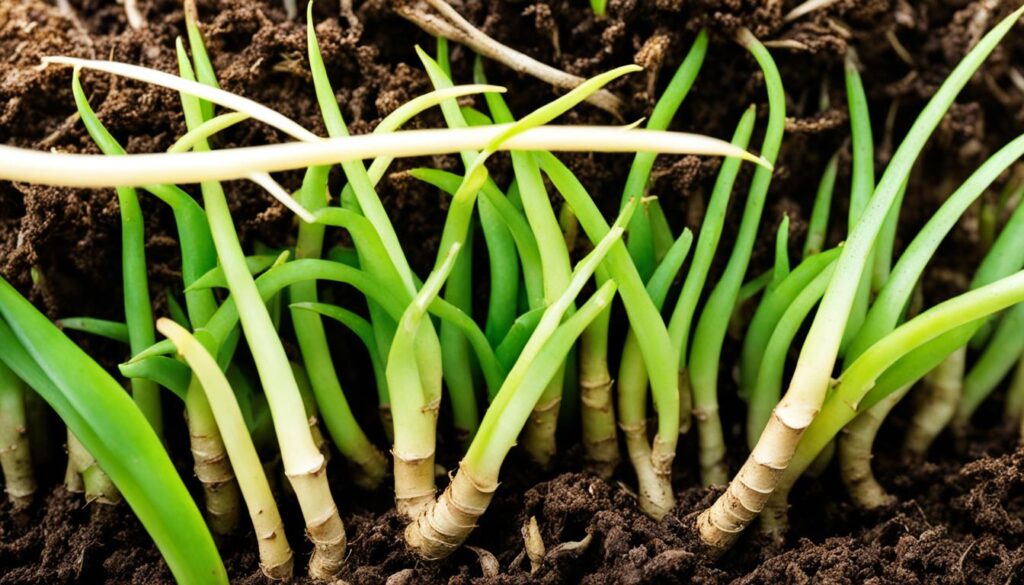
| Care Tips for Ginger Root Growth | Benefits |
|---|---|
| Provide warmth | Creates a favorable environment for ginger plants |
| Maintain humidity | Simulates the plant’s natural habitat and supports growth |
| Ensure proper moisture | Prevents drying out or waterlogging |
| Use mulch | Conserves moisture and suppresses weed growth |
Conclusion
Growing ginger successfully requires replicating its tropical natural habitat as closely as possible. Providing optimal soil conditions, the right temperature range, adequate moisture, and dappled shade is crucial. By following these best practices, gardeners can ensure the best conditions for ginger root growth and enjoy a bountiful harvest.
When it comes to planting ginger, there are two main methods: using whole rhizomes or cutting them into pieces and pre-sprouting indoors for an earlier harvest. Both approaches can be effective, but it’s important to pay careful attention to watering and drainage. Ginger cannot tolerate standing water or drying out completely, so finding the right balance is key.
Remember that ginger thrives in warm temperatures, ideally ranging from 70° to 90°F (21° to 32°C). Additionally, ginger plants appreciate some dappled shade, as it protects them from direct sunlight and helps prevent the soil from drying out too quickly. Creating these optimal conditions will give your ginger the best chance to grow and thrive.
So whether you’re growing ginger in the ground, in containers, or in a greenhouse, make sure to provide it with the right environment. By replicating its tropical natural habitat as closely as possible and paying attention to its specific needs, you can enjoy a bountiful harvest of delicious and aromatic ginger roots.
FAQ
What are the best conditions for ginger root growth?
What are the optimal soil conditions for ginger root growth?
What is the ideal temperature range for ginger root growth?
How important is moisture for ginger root growth?
What are the benefits of dappled shade for ginger root growth?
What are the recommended planting techniques for ginger root growth?
What are the care tips for ginger root growth?
- About the Author
- Latest Posts
Meet Katherine, the creative enthusiast at ByRetreat who infuses her boundless passion for design into every remote workspace she crafts. With an innate sense of creativity and an eye for unconventional beauty, Katherine brings a unique and inspiring perspective to the team.
Katherine’s love for design is infectious, and her ability to think outside the box sets her apart. She believes that true artistry lies in embracing a variety of styles and mixing them harmoniously to create captivating spaces. By combining different textures, colors, and patterns, Katherine weaves a tapestry of creativity that breathes life into each remote workspace.
Plants
Flower Bed Ideas
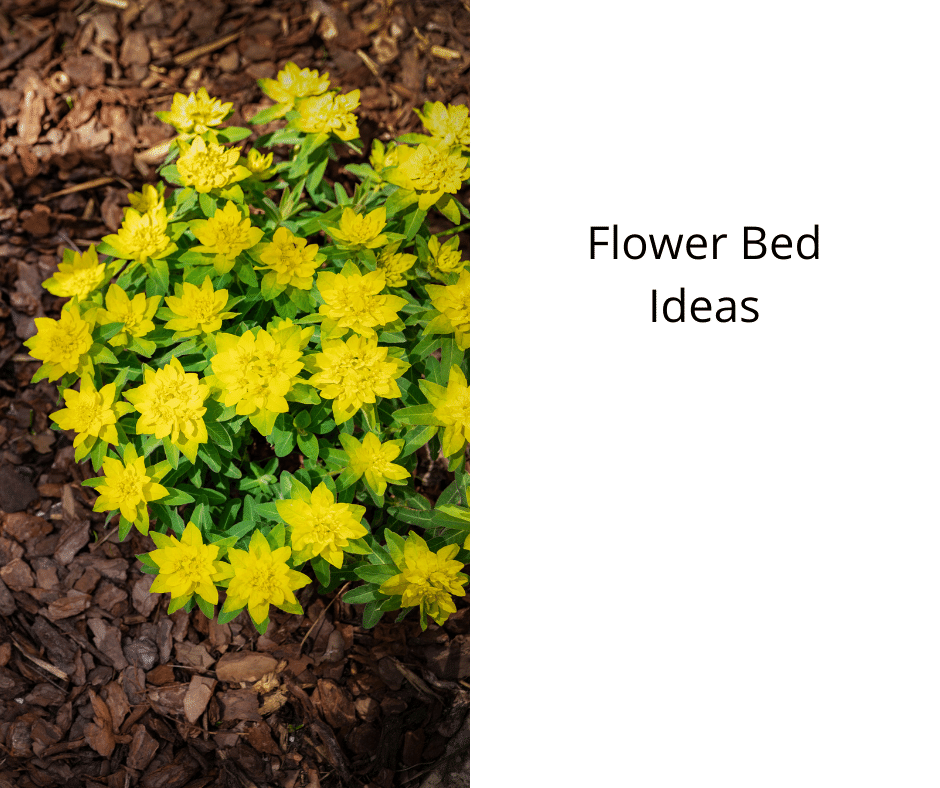
If you want to add a splash of color to your garden bed, there are various methods you can try. From planting tulips in a pot, to adding hydrangeas, succulents, and even a trellis, these ideas are simple to execute and will enhance the beauty of your flower bed.
Planting Tulips in Pots
Planting tulips in pots is a beautiful way to decorate your flower bed. They will last much longer than cut flowers and can be brought indoors to keep your room looking fresh. However, they will die once you cut them. Planting tulips in pots is a great alternative to planting them in the ground, and they look great in window boxes, too.
When planting tulips in pots, it is important to remember that the soil in your pot should have a drainage hole in it. This will help to keep your flowers from drowning in water. You can use Miracle-Gro Potting Mix to fill the pot.

In case your soil is heavy, mix some sand in it to make it lighter. You should then plant your bulbs four to six inches deep. The spacing between each bulb should be 4 inches (10 cm). You can also use bulb planters to make the process easier.
Tulips grow best in full sun. If your flower bed is shaded, plant them under a leafless tree. They are inexpensive and colorful, and blend in well with other spring flowers. Another bonus: tulips are edible! Planting tulips in pots is a great way to add color and interest to your flower bed.
Planting Hydrangeas
Hydrangeas are a great plant to incorporate into your flower bed ideas. They can be grown in large pots and are an eye-catching addition to your outdoor space. Plant them in early spring or fall to give them plenty of time to establish a robust root system. During the first spring, water them well to ensure they are correctly established.
Hydrangeas are an easy plant to grow. They are hardy in zones 3 to 9, and they can grow as large as 15 feet tall. Their flowering season varies depending on the variety, but most will bloom throughout the summer and into fall. The blooming time for hydrangeas varies by variety, but many varieties can tolerate full sun.

Hydrangeas can be pruned to make them look tidy. Pruning them does not require major surgery, but it will enhance their structure and allow them to breathe. You can choose to prune your hydrangeas in late spring or early summer, but keep in mind that pruning is only necessary for plants with a mature flower head.
If you are planting hydrangeas in flower bed ideas, you can buy a one-gallon shrub. This type of plant will have more extensive roots, which means it can establish itself quickly and have a dramatic impact. Alternatively, you can grow hydrangeas from seed. When starting a new plant, make sure that you cover it with a layer of soil and do not bury the seeds.
Planting Succulents
Before planting succulents, you should know about how to prepare the soil. Generally, succulents need at least six inches of specialized soil. You can add sand or organic material to improve drainage. The soil should have adequate space to grow roots and should be moist but not dry. This will help prevent weeds and conserve moisture.
Succulents need regular watering to keep them healthy and to grow well. However, you should make sure that they dry out between waterings, as it gives them breathing space. The frequency of watering will depend on the soil and weather conditions. Some varieties may go for weeks or months without water.
Planting succulents in containers is a great way to add color to any flower bed. They are small enough to fit into a small space and can colonize it quickly. Alternatively, you can plant them in cracks in concrete or brick. Echeverias and sempervivums are hardy plants and can even be planted in concrete.

Planting succulents in a flower bed requires a bit of planning. Start by choosing succulents that are easy to grow and maintain. For beginners, it’s best to go for easy-care, low-maintenance species, such as Sempervivum or Sedum. When arranging your succulents in a flower bed, try to place the tallest species in the center, and the smaller ones on the edges, or between larger plants.
Planting a Trellis
A trellis gives a flower bed a nice architectural touch. It also secures climbing plants and adds privacy. There are many different types of trellises. Some are made of wood, while others are made of metal. The trellis you choose depends on what you want to grow in your flower bed.
A simple trellis can be purchased for a fair price. A more elaborate one can be made with more time and effort. There are many types of trellises available, and you can choose from a number of classic and unusual designs. The classic style is simple but elegant, a square grid that looks perfect when vines cover the trellis. You can make a trellis using the right tools and measurements.

Another type of trellis is a triangular trellis. This trellis is useful for supporting annual vines. Plants that grow up the triangular structure have a tendency to grow horizontally.
Planting Grasses
Grassy flower beds can provide a beautiful backdrop for the flowering plants in your garden. You can plant several different types of grasses to create a variety of textures and colors. Most varieties are annuals, so you will not have to worry about transplanting or dividing them. In addition, few pests bother grasses. Most of them can be controlled with regular watering.
While grasses can be used in various ways, they are best suited for large areas. They can be used in combination with perennials to help define a border or to define spaces within a flower bed. There are even several varieties of grasses that grow in large mats.

Before planting grasses, be sure to choose a shady spot where the sun won’t burn them. Shaded areas can be perfect for Norther sea oats and black mondo. Tall grasses can also be planted in terracotta pots. You should also remove the old growth before planting. This will help new growth thrive in the spring.
Depending on the species, you can plant grasses in your flower beds during spring and autumn. Different grasses have different growing conditions and require different amounts of care. Some prefer moist soil while others prefer dry soil. Most grasses prefer full sun, though some can also tolerate partial shade. Some require periodic cutting and division during the spring.
Planting a Patterned Border
Planting a patterned border in flower bed can add visual interest to your flower bed. You can also mix up colors or plants and place them randomly around the border. It’s important to avoid creating distinct clumps of one color. Instead, use a mix of colors that will make the border more cohesive.
Consider using colorful perennials and annuals. They will brighten the border while also providing long-lasting color and a low cost. A solid-green groundcover will also help you keep the border from looking too busy. You can also use evergreen shrubs for their distinctive plant forms and color.
When planning the design for your border, remember that it’s not a difficult process. You should know the plant habits and flowering times of your chosen plants. You can then decide on a colour theme and fill in the gaps with matching plants as the season progresses.

A border needs periodic maintenance, and it’s important to embrace the fact that your border will change over time. Some species will disappear and others will grow. To keep the design fresh, you can do some minor maintenance in spring and fall. You can also weed the border or lift up rampant plants.
Planting Roses
One of the first steps when planting roses in a flower bed is determining the best spot for them. The best spots for roses are those that receive full sun most of the day. Roses in colder climates should be planted in partial shade during the afternoon. This will prevent blossoms from being scorched and help them last longer. It is important to keep the soil moist and free of weeds. Roses also need good air circulation and well-drained soil.

Roses should be planted in well-prepared soil that is slightly acidic. Soils with a pH of 6.5 are ideal for most roses. You can test the soil’s pH by using a soil test kit. If the soil is too acidic or alkaline, you can add sulfur or finely ground limestone to balance it. When planting bare-root roses, make sure that they are thoroughly wet before planting. The roots should remain moist for eight to 12 hours before planting. Once the roots have been prepared, dig a hole at least two inches deep and twice as wide as the root’s length.
After planting roses, keep an eye out for aphids and other pests. These insects feed on the leaves and flowers of roses. Luckily, most of these pests are easily controlled by neem oil or insecticidal soap. Roses that are susceptible to aphids can be protected by planting alliums around them.
- About the Author
- Latest Posts
Introducing Ron, the home decor aficionado at ByRetreat, whose passion for creating beautiful and inviting spaces is at the heart of his work. With his deep knowledge of home decor and his innate sense of style, Ron brings a wealth of expertise and a keen eye for detail to the ByRetreat team.
Ron’s love for home decor goes beyond aesthetics; he understands that our surroundings play a significant role in our overall well-being and productivity. With this in mind, Ron is dedicated to transforming remote workspaces into havens of comfort, functionality, and beauty.
Beginners Guides
The Best Fake Plants for Your Home – That Don’t Look Fake
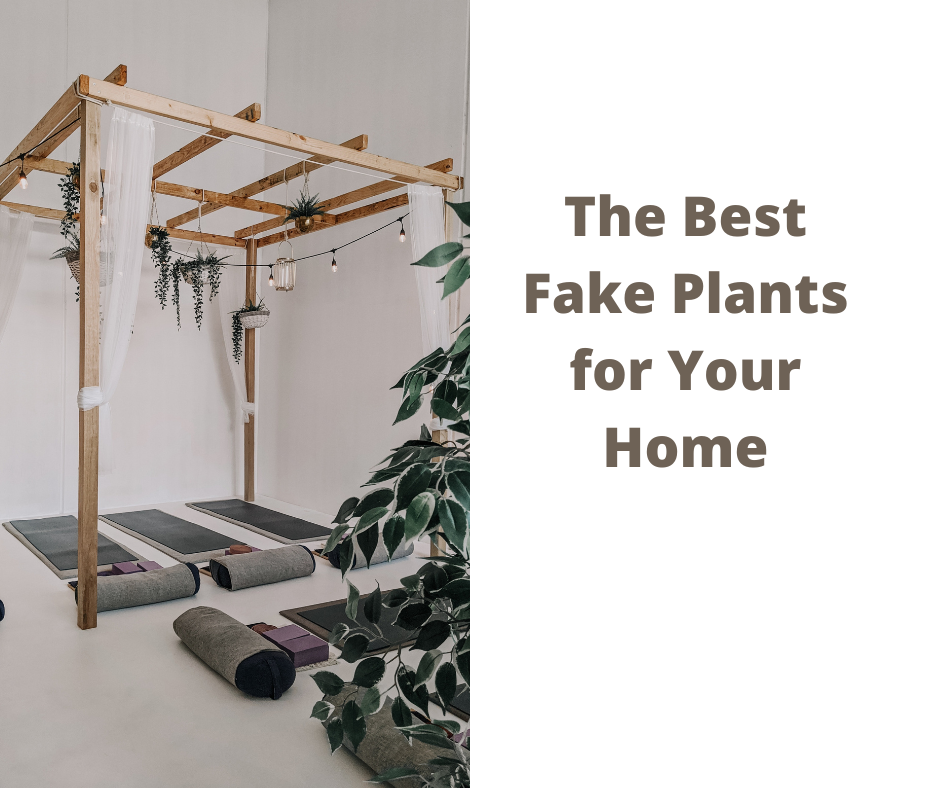
When it comes to bringing greenery into your home, there are two different perspectives. Some individuals insist on using real plants, while others are content with artificial ones. Each approach has its advantages and disadvantages, but if you decide to go with fake plants, it’s important to consider a few factors. Start by selecting a plant that suits the specific area where you intend to place it.
A plant thrives in low-light conditions and will not look very good in a sunny spot. Second, make sure the materials the plant is made from look realistic. Artificial plants made of plastic or silk are often quite obvious, while those made of more natural materials like wood or paper can be much more convincing. Finally, don’t forget to dust and clean your fake plants regularly. A little bit of upkeep will go a long way towards making them look their best.
Best Fake Plants
Are you looking for some new plants to add to your home décor but don’t want the hassle of taking care of them? Check out our list of the best fake plants! These artificial plants look so real that you’ll be surprised at how great they look in your home. Plus, they require no maintenance so that you can enjoy their beauty without fuss.
Fake Plants Are a Great Choice
Nothing like a touch of greenery brightens up a room, but keeping real plants alive can be challenging. Fake plants offer the beauty of the real thing without any hassle, and they’re becoming increasingly realistic. New technologies have made artificial plants look more lifelike than ever before, making them a great option for anyone who wants to add a touch of nature to their home without any work.

Fake plants are also incredibly versatile. They come in a wide range of styles and sizes, so it’s easy to find one that fits your décor. Best of all, they require no watering or maintenance so that you can enjoy them hassle-free. Whether you’re looking for a low-maintenance option or simply can’t keep real plants alive, fake plants are a great choice.
Best Overall – 6ft Artificial Fiddle Leaf Fig Tree (72in)
There’s no doubt about it, fiddle leaf fig trees are beautiful. But for those who don’t have a green thumb, caring for a living plant can be daunting.
[affiliatable id=’99536′] Thankfully, there are plenty of great faux options on the market, and the OXLLXO Artificial Fiddle Leaf Fig Tree is one of the most realistic-looking. The tree features a series of narrow trunks and thin branches dotted with lush leaves. These leaves are soft, and the branches are adjustable, so you can customize the tree to suit your space. Plus, there’s no need to worry about watering or fertilizing—just enjoy your beautiful tree!
Best Budget – Faux Plants Indoor
Updating your décor can be a fun way to refresh your space, but it can also be a costly undertaking. Consider opting for a faux plant if you’re looking for a dramatic update that won’t break the bank. Faux plants have come a long way recently, and many are incredibly realistic.
[affiliatable id=’99547′]
Nearly Natural’s Golden Cane Palm Silk Tree is a prime example. The plant is a whopping 6’6” tall, so it should make a statement in any room. And since its leaves are crafted from delicate silk, they look incredibly realistic. Plus, the tree comes in a stylish planter that will elevate your space. Whether you’re looking to add a touch of nature to your décor or simply want to make a bold statement, this faux plant is up to the task.
Forever Leaf has a great selection of affordable artificial plants if you’re looking for a way to add some green to your space without breaking the bank. Whether you’re looking for a small potted plant to spruce up your desk or a large floor plant to add some life to your living room, Forever Leaf has a wide variety of options.
And unlike real plants, these faux plants require no watering or maintenance so that you can enjoy their beauty without any hassles. So if you’re looking for an easy and budget-friendly way to add some greenery to your space, check out Forever Leaf.
Best Palm – Nearly Natural 6.5ft. Golden Cane Palm Silk Tree
The Nearly Natural 6.5ft. Golden Cane Palm Silk Tree is an elegant addition to any room. The palm tree is known for its ability to thrive in warm climates, and its beautiful golden leaves add a touch of luxury to any setting. The Nearly Natural 6.5ft. Golden Cane Palm Silk Tree is also remarkably easy to care for.
[affiliatable id=’99549′]
The faux tree is a beautiful addition to any home. With three narrow trunks and 333 palm leaves, it is incredibly realistic and easily the most lifelike of all the fake plants of its kind. I found it easy to move from room to room, and loved how it looked in her home. The pot is black, but if you’re looking for something with more flair, you can easily swap it out for something else. The tree weighs only 11 pounds, making it easy to transport. It is also very easy to assemble and looks great in any space. This is the one for you if you’re looking for a beautiful, realistic fake tree.
Unlike real palm trees, it doesn’t require regular pruning or watering, and it can be enjoyed for years with minimal upkeep. Whether you’re looking to add a touch of the tropics to your home or simply want an attractive and low-maintenance plant, the Nearly Natural 6.5ft. Golden Cane Palm Silk Tree is a perfect choice.
Best Monstera – Artificial Monstera Deliciosa Plant 37″
The Best Monstera – Artificial Monstera Deliciosa Plant is a replica of the real thing, down to the smallest detail. It stands 37″ tall and is made from high-quality materials, making it durable and long-lasting.
Monstera plants are a beautiful addition to any corner. This lifelike fake monstera deliciosa plant with superb detailing is the perfect substitute for a real tree because it mimics the natural branches, and foliage of a real thing.
[affiliatable id=’99565′]
To use this artificial tree for interior décor, you don’t have to worry about watering, trimming, or applying fertilizer. This makes it an ideal choice for people who want all the beauty of a real plant without any hassle. Whether you’re looking to add a touch of nature to your home or office, these plants are a perfect way to do it.
Best Orchid: White Realistic Artificial Phalaenopsis Orchids
Orchids are a beautiful, elegant addition to any home. They come in many different colors, but white orchids are particularly stunning. White Realistic Artificial Phalaenopsis Orchids are the best type of artificial orchids because they look real. The petals are made of a soft, silky material that looks just like real orchid petals. They also have realistic-looking leaves and stems.
These orchids come in various sizes to choose the perfect one for your home. You can also find them in different price ranges, depending on how many you want to buy. Whether you’re looking for a single orchid to add to a vase or an entire set to decorate your home, White Realistic Artificial Phalaenopsis Orchids are a perfect choice.
[affiliatable id=’99567′]
Thanks to their beautiful blooms and graceful stature, orchids are among the most popular houseplants. However, they can also be notoriously finicky, requiring precise watering and humidity levels to thrive. If you don’t have the time or patience to care for a real orchid, a faux option like The Faux Orchid Phalaenopsis is a great alternative.
This lifelike artificial plant features intricate details and realistic blooms that will fool even the most discerning eye. Best of all, it’s incredibly low-maintenance, requiring nothing more than an occasional dusting to keep it looking its best. So if you’re looking for an elegant houseplant that won’t require constant attention, The Faux Orchid Phalaenopsis is a perfect choice.
Best Succulents – 16 Pack Artificial Succulent Flocking Plants Unpotted Mini Fake Succulents Plant
If you’re looking for a low-maintenance way to add some greenery to your space, look no further than these artificial succulent plants. These picks are made of a soft, flocked material that looks realistic, yet is easy to care for.
[affiliatable id=’99556′]
Simply insert them into a planter of your choice and enjoy the look of a healthy succulent garden without hassle. These plants are versatile and can be used in various settings, from office cubicles to wedding centerpieces. So whether you’re looking to add a touch of nature to your decor or searching for an easy way to spruce up your space, these artificial succulent plants are the perfect solution.
These artificial succulents worked out great for the wreath I made for a customer. The succulents looked very realistic and I received many compliments from people who saw it. The succulents are usually quite costly, so this was a great deal. I’m picky about these things, but even up close, these looked real.
For a 14″ wreath, I required 2 orders of these succulents and some additional greenery. overall, I was very happy with this product.
Best Hanging Basket – Bougainvillea Hanging Basket Silk Plant
Hanging plants are a great way to add a splash of color to your home without taking up valuable floor space. This hanging basket plant from Nearly Natural is a beautiful option with a rich pink hue. The faux flowers and cascading vines look and feel surprisingly real, thanks to the brand’s horticulturist-approved design. Plus, there’s no need to worry about watering this plant— simply enjoy its fresh look without the hassle.
[affiliatable id=’99570′]
If you’re looking for a cascading bougainvillea that will make a statement, look no further than the Nearly Natural. Bougainvillea Hanging Basket Silk Plant.
This beautiful plant is crafted with South American bougainvillea and features three delicate pastel petals surrounded by a mix of tiny cream-colored flowers. The cascading vines extend gracefully around a traditional wicker planter, and the lush leaves complement the vibrant blooms.
Best Artificial Arrangement – aux Eucalyptus Plants in Rustic Rectangular Wood Planter Box
Looking for a beautiful and realistic faux eucalyptus plant to add to your décor? Look no further than our Faux Eucalyptus Plant in Rustic Rectangular Wood Planter Box! This wonderful arrangement comes with artificial eucalyptus plants in two-tone green color, nestled in a rustic wooden planter box.
The dusty look of the plants makes them appear more realistic, making them a wonderful tabletop decoration or floral centerpiece for any occasion.
[affiliatable id=’99573′]
This Faux Eucalyptus Greenery Arrangement is the perfect way to add a touch of nature to your home or office décor. The artificial leaves and branches are crafted with realistic detail, and the vibrant green color is sure to brighten any space.
The arrangement comes in a black plastic pot, making it easy to display on a table, desk, or shelf. It is a great gift for housewarming, weddings, and Mother’s Day. Whether looking for a beautiful centerpiece for your dining room table or a simple way to spruce up your office décor, this Faux Eucalyptus Greenery Arrangement is a perfect choice.
- About the Author
- Latest Posts
Meet Bethia, the visionary designer at ByRetreat who brings a touch of magic to every remote workspace she creates. With a boundless imagination and an eye for beauty, Bethia is passionate about transforming ordinary spaces into extraordinary havens of creativity and comfort.
Bethia possesses a unique talent for envisioning the perfect combination of furniture, colors, and textures that harmonize seamlessly in a room. She understands that selecting furniture goes beyond mere functionality; it’s about curating pieces that evoke a sense of style and sophistication while enhancing the overall ambiance.
Plants
Ideal Hydrangea Spots: Best Place to Plant Hydrangeas
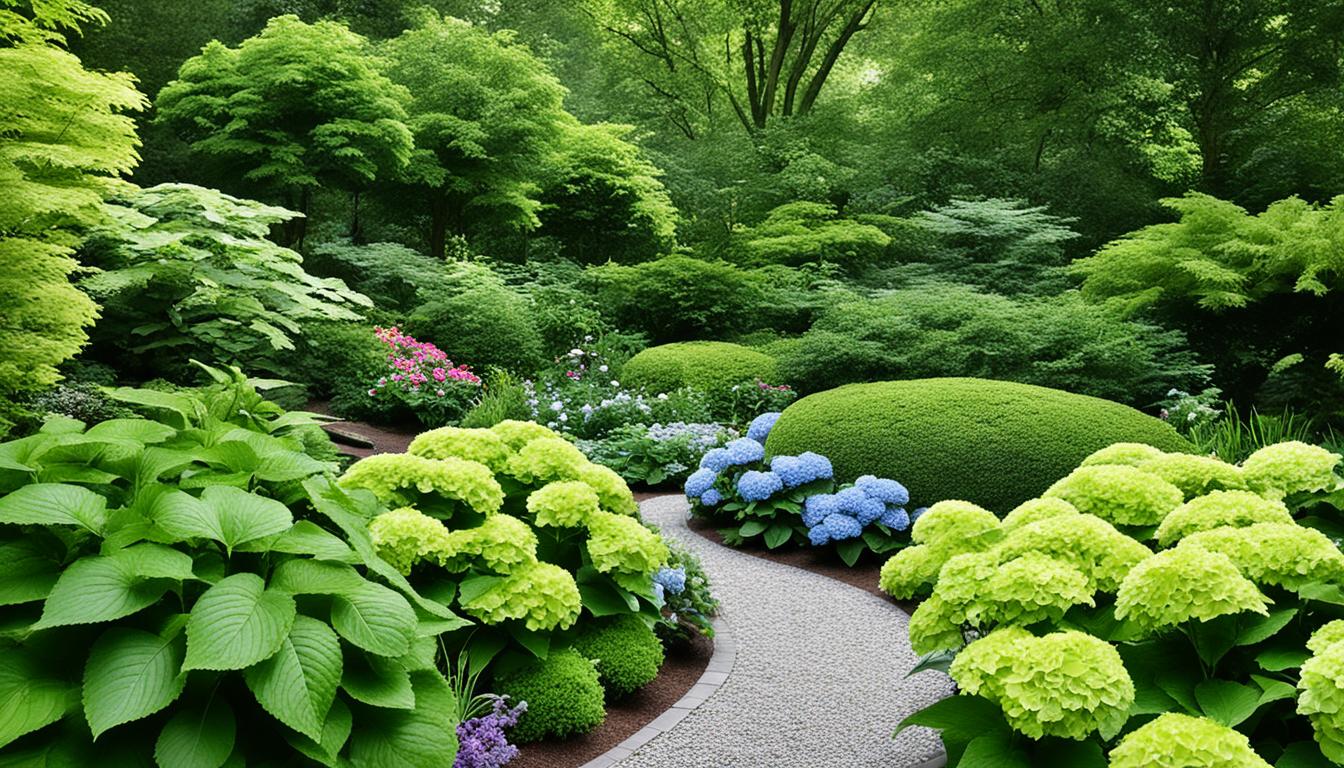
Did you know that the location where you plant your hydrangeas can have a significant impact on their growth and vibrancy? Finding the best place to plant hydrangeas is essential for optimal growth and to ensure that you get the most beautiful blooms.
In this guide, we will explore the different factors to consider when selecting the ideal spot for your hydrangeas. Whether you have a sunny garden or a shady corner, we’ll help you choose the right hydrangea varieties to thrive in various sun and shade conditions. By understanding their sunlight preferences and caring for them properly, you can enjoy vibrant and healthy hydrangea blooms year after year.
Key Takeaways:
- Choosing the right location is crucial for the growth and vibrancy of hydrangeas.
- Hydrangeas can thrive in different sunlight conditions, from full sun to partial shade.
- Consider the specific sunlight needs of different hydrangea varieties for optimal results.
- Proper care, including pruning, fertilizing, and watering, is essential for healthy blooms.
- By following our planting guide and care tips, you can transform your garden with stunning hydrangea displays.
Hydrangeas for Part Shade: Give Us Some Sunblock Please
When it comes to creating the perfect environment for hydrangeas, finding the right balance of sun and shade is key. While some hydrangea varieties thrive in full sun, others prefer a location with partial shade, where they can benefit from the morning sun and enjoy relief from the scorching afternoon rays. These hydrangeas are like beachgoers who know the importance of sunblock, seeking a little shade to protect themselves from the intense heat.
In the family of hydrangeas, there are several popular cultivars that are well-suited for part shade conditions. These varieties have the ability to produce stunning blooms when provided with a combination of filtered light and a few hours of full sun. Among them are the beloved Endless Summer® Hydrangea series, which includes BloomStruck®, Endless Summer®, Blushing Bride®, and Twist-n-Shout®.
Another great choice for morning sun and afternoon shade is the Annabelle Hydrangea, which is known for its spectacular large white flowers. And let’s not forget the many bigleaf hydrangea cultivars that can handle part shade and reward you with their vibrant blossoms.
Here are a few remarkable hydrangea varieties that thrive in part shade:
| Hydrangea Variety | Light Requirements |
|---|---|
| Endless Summer® series (BloomStruck®, Endless Summer®, Blushing Bride®, Twist-n-Shout®) | Morning sun, afternoon shade |
| Annabelle Hydrangea | Morning sun, afternoon shade |
| Bigleaf hydrangea cultivars | Morning sun, afternoon shade |
These hydrangeas have adapted to thrive in part shade by enjoying the gentle morning sun and being sheltered from the intense afternoon heat. This combination of light conditions allows them to produce their enchanting blooms and add a touch of elegance to any garden or landscape.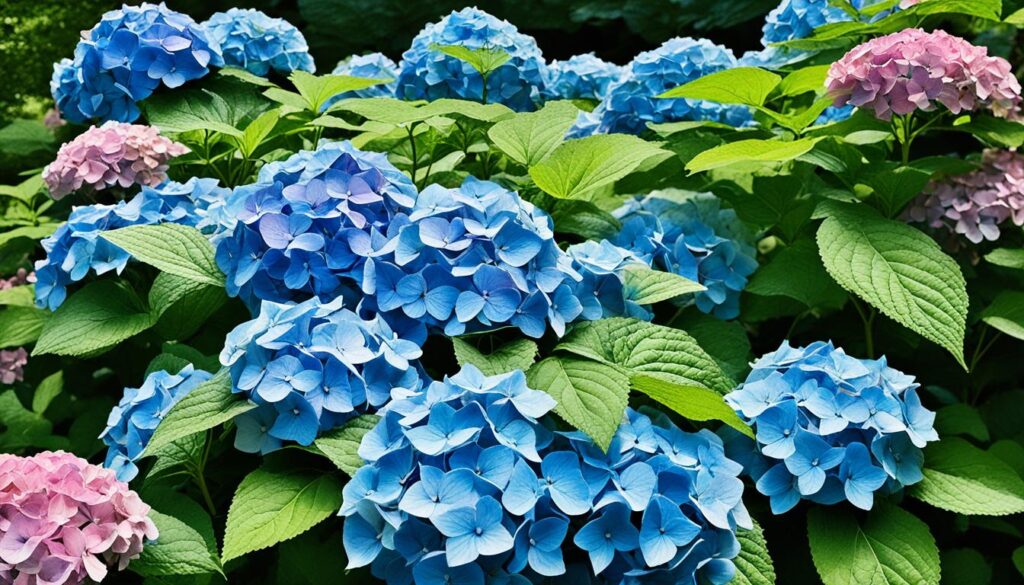
So, if you have a garden or yard with a mix of sunlight and shade, don’t worry! There are plenty of beautiful hydrangeas that will thrive in this environment. Just give them some sunblock (in the form of morning sun) and watch as their blooms light up your space with their breathtaking beauty.
Hydrangeas for Full Sun: We Like It Sunny
While most hydrangeas prefer some shade, there are certain varieties that can thrive in full sun. If your garden gets plenty of sunlight, don’t worry! There are hydrangeas that will flourish in these conditions and reward you with beautiful blooms.
Panicle Hydrangeas
Panicle hydrangeas, known for their cone-shaped flower clusters, are excellent choices for full sun exposure. They can tolerate the direct heat and intense sunlight, making them perfect for sunny spots in your garden. Some popular panicle hydrangeas include:
- Fire Light®
- Limelight
- Pinky Winky®
- Strawberry Sundae®
- Vanilla Strawberry®
Dwarf Varieties
If you have limited space or prefer compact hydrangeas, consider the Let’s Dance® and Cityline® series. These dwarf varieties are perfect for both full sun and part sun environments. They offer the beauty of hydrangeas in a smaller package without compromising on vibrant blooms.
Smooth Hydrangeas
Smooth hydrangeas are another type that can handle full or part sun conditions. These varieties are known for their large rounded flower heads and are a great choice for a sunny garden. Consider the following smooth hydrangeas:
- Incrediball®
- Invincibelle® Ruby
With these hydrangeas, you can enjoy the beauty and charm of these flowering plants even in full sun areas. Just make sure to provide them with proper care and maintenance, including regular watering and occasional fertilization.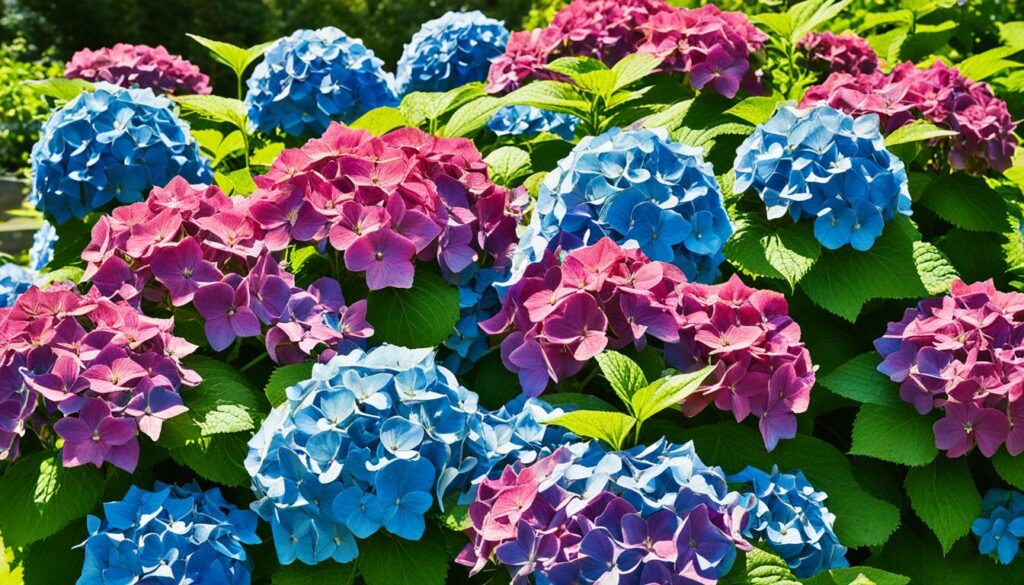
Overall, including hydrangeas that thrive in full sun can add a splash of color and vibrancy to your garden. Whether you choose panicle hydrangeas, dwarf varieties, or smooth hydrangeas, these sun-loving beauties will brighten up any sunny corner of your outdoor space.
Growing Hydrangeas in Different Sun and Shade Conditions
When it comes to growing hydrangeas, understanding their sunlight requirements is essential for their success. While many hydrangea varieties thrive in partial shade, oakleaf hydrangeas are known for their adaptability to different sun and shade conditions.
In the northern parts of the United States, oakleaf hydrangeas can tolerate full sun. However, in warmer and southern climates, they prefer some afternoon shade to protect them from excessive heat and sun exposure. This makes them an excellent choice for those looking to plant hydrangeas in regions with varying temperature and sunlight conditions.
What makes oakleaf hydrangeas unique is their ability to also tolerate full shade. This makes them ideal for areas of the garden that receive little to no direct sunlight. Whether it’s a densely shaded corner or underneath taller trees, oakleaf hydrangeas can thrive and add beauty to areas that are typically challenging for other hydrangea varieties.
It’s important to note that while oakleaf hydrangeas are the most adaptable, other hydrangea varieties have specific sunlight needs. When selecting the location for planting, it’s crucial to consider the specific requirements of each hydrangea type to ensure optimal growth and vigor.
By carefully assessing the sunlight conditions in your garden and selecting the appropriate hydrangea varieties, you can create a diverse and captivating display of hydrangeas that thrive in different sun and shade conditions.
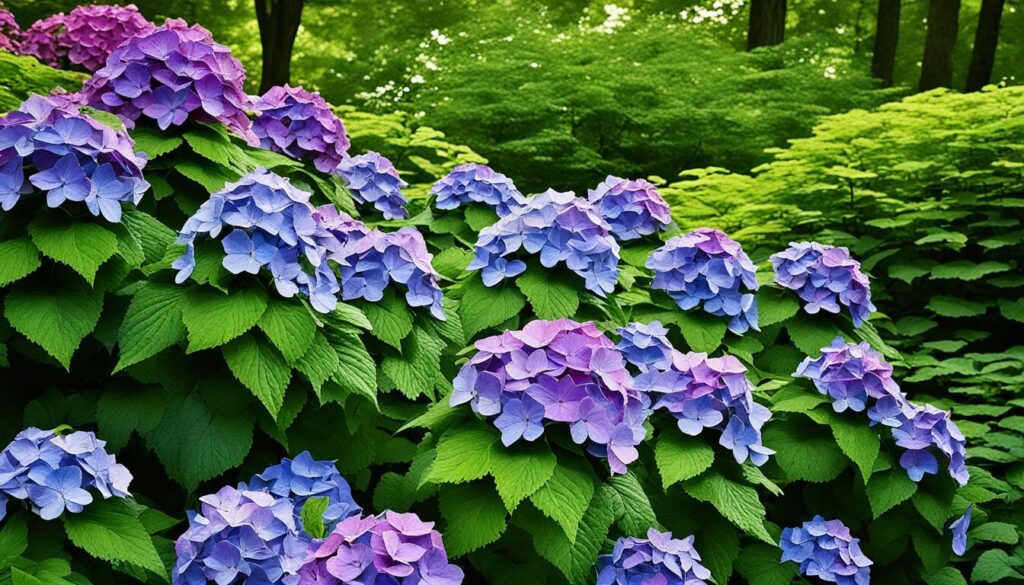
Pruning and Caring for Hydrangeas
Proper pruning and care are essential for the health and vitality of hydrangeas. By implementing appropriate pruning techniques and providing the necessary care, gardeners can ensure the longevity and abundant blooming of their hydrangea plants. Here are some important tips to consider:
Understanding Pruning Methods
When pruning hydrangeas, it’s crucial to understand whether the plant blooms on old wood or new wood. This knowledge will help gardeners avoid accidentally cutting off next season’s flowers.
Tip: Prune hydrangeas that bloom on old wood immediately after flowering. This allows for new growth and development of flower buds for next year. On the other hand, hydrangeas that bloom on new wood can be pruned during late winter or early spring before new growth begins.
Optimal Soil Conditions
Hydrangeas thrive in well-drained soil that is rich in organic matter. A mixture of compost and native soil is ideal for providing the necessary nutrients and moisture retention.
Fertilizing for Healthy Blooms
To promote healthy blooming, it’s recommended to fertilize hydrangeas with a slow-release fertilizer that is high in phosphorus. Phosphorus is essential for promoting flower production and overall plant vitality.
Preventing Leaf Scorch
Hydrangeas are susceptible to leaf scorch, especially during hot and dry periods. To prevent leaf scorch, it’s important to provide hydrangeas with extra water and ensure they have adequate moisture in the soil.
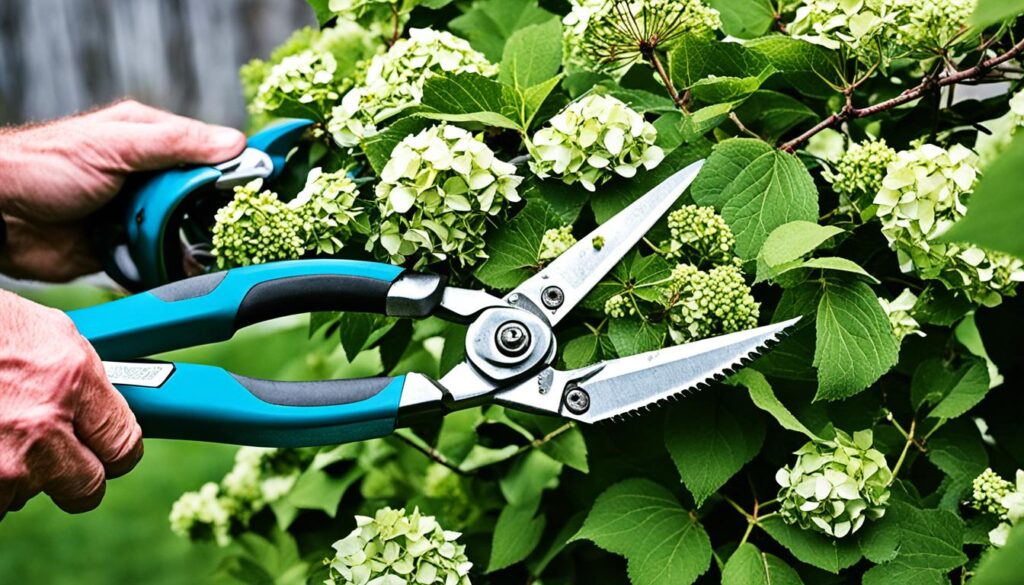
Summary of Pruning and Care Tips
| Pruning Method | Soil Conditions | Fertilizing | Preventing Leaf Scorch |
|---|---|---|---|
| Prune hydrangeas that bloom on old wood immediately after flowering | Well-drained soil with organic compost | Use slow-release fertilizer high in phosphorus | Provide extra water during hot and dry periods |
By following these pruning and care tips, hydrangea enthusiasts can enjoy lush, vibrant blooms year after year. With proper maintenance, these stunning plants will continue to beautify gardens and landscapes.
Conclusion
Planting hydrangeas in the best location and providing proper care and maintenance are key to achieving beautiful and vibrant blooms. By selecting the right spot that balances sun and shade, ensuring well-drained soil, and following recommended pruning and watering practices, gardeners can enjoy the full potential of their hydrangea plants. With the right planting and care, hydrangeas can transform any garden into a colorful and inviting space.FAQ
What is the best place to plant hydrangeas?
What are the best types of hydrangeas for morning sun and afternoon shade?
Can hydrangeas grow in full sun?
Which hydrangea varieties are best for full shade?
How should I prune and care for hydrangeas?
Are there any tips for planting and caring for hydrangeas?
- About the Author
- Latest Posts
Meet Katherine, the creative enthusiast at ByRetreat who infuses her boundless passion for design into every remote workspace she crafts. With an innate sense of creativity and an eye for unconventional beauty, Katherine brings a unique and inspiring perspective to the team.
Katherine’s love for design is infectious, and her ability to think outside the box sets her apart. She believes that true artistry lies in embracing a variety of styles and mixing them harmoniously to create captivating spaces. By combining different textures, colors, and patterns, Katherine weaves a tapestry of creativity that breathes life into each remote workspace.
-

 Vetted12 hours ago
Vetted12 hours ago15 Best Tile Adhesives for Outdoor Use – Top Picks for Durable and Weather-Resistant Installations
-

 Vetted1 day ago
Vetted1 day ago15 Best Plants to Thrive on the North Side of Your House – A Gardener's Guide
-

 Vetted1 week ago
Vetted1 week ago15 Best Boxwood Varieties for Thriving in Full Sunlight
-

 Vetted2 weeks ago
Vetted2 weeks ago15 Best Ways to Label Clothes for Nursing Home Residents – Stay Organized and Efficient
-

 Decor3 days ago
Decor3 days agoAre Home Decor Stores Profitable?
-

 Vetted1 week ago
Vetted1 week ago15 Best Dryer Vent Hoses to Keep Your Laundry Room Safe and Efficient
-

 Vetted1 week ago
Vetted1 week ago14 Best Cleaners for Aluminum Surfaces – Shine Bright Like a Diamond
-

 Vetted1 week ago
Vetted1 week ago15 Best Spider Sprays to Keep Your Home Arachnid-Free




























